
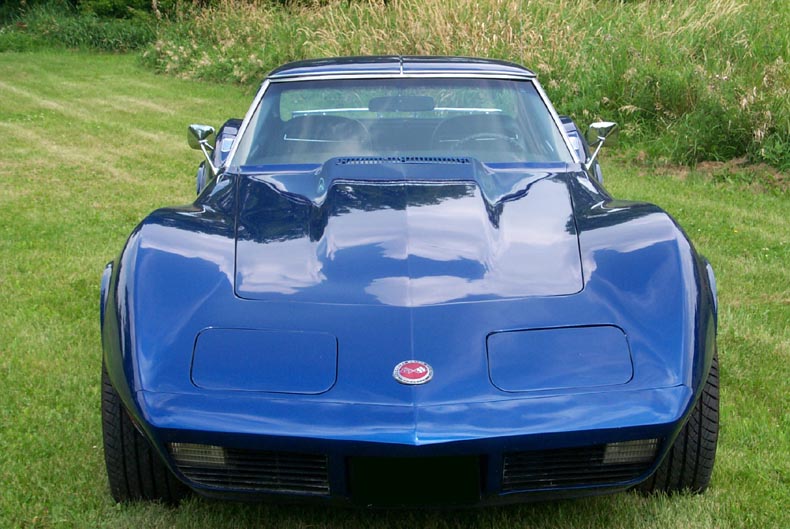
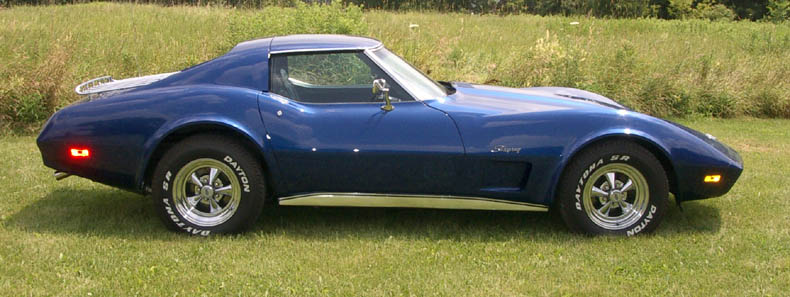
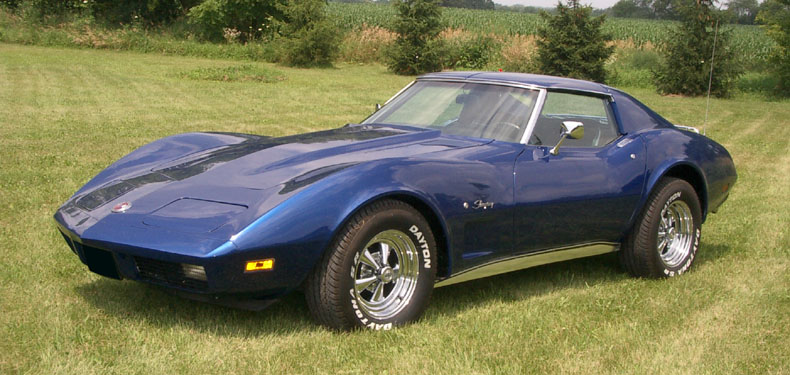
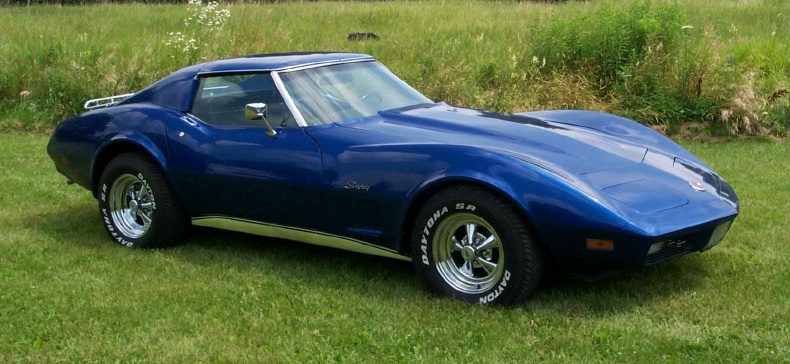
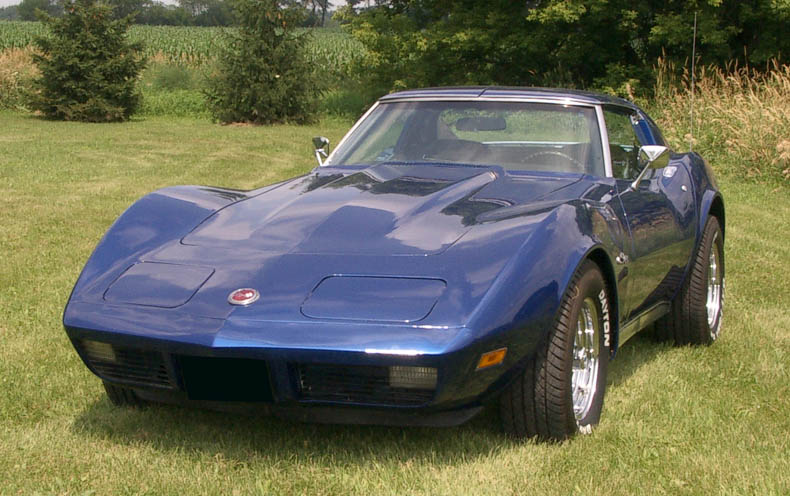
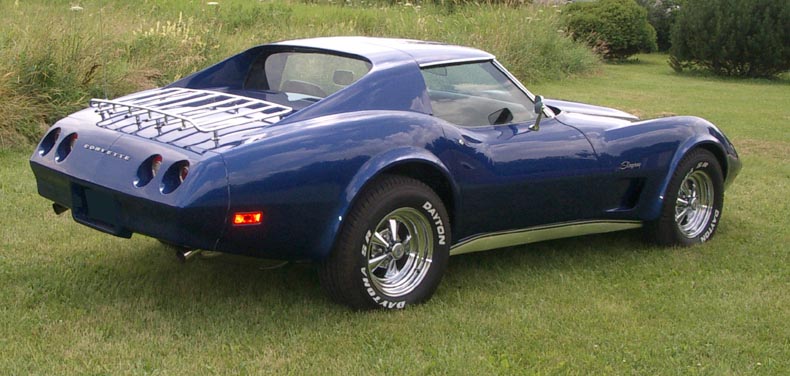
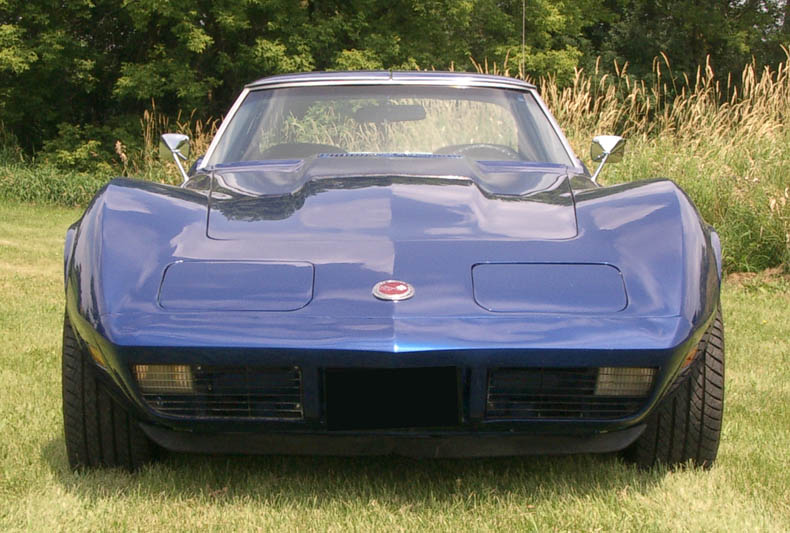
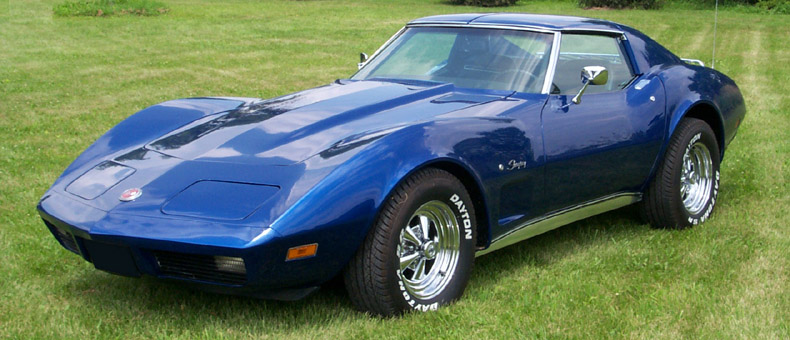
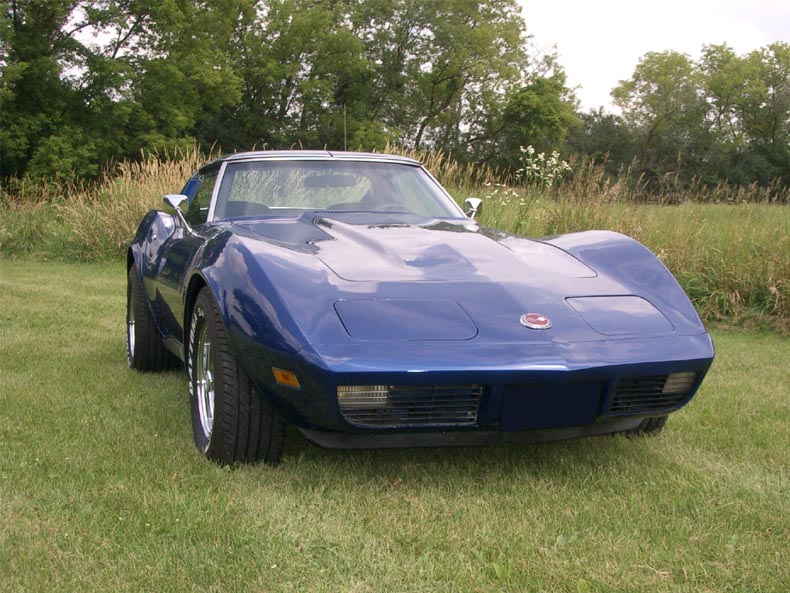
1973 started Corvette's transformation from muscle to touring sports car. A Chevrolet advertisement headlined: "We gave it radials, a quieter ride, guard beams and a nose job. Indeed, redesigned body mounts and radial tires did improve Corvette's ride, and interior sound levels were reduced by 40%. The chrome blade front bumper was dropped for the federally required 5-mph standard for a light-weight front bumper system with an inner transverse tube attached to the frame with two Omark-bolts-(special steel fasteners which absorbed energy when a forming die, pushed back by the bumper, was forced down their length), and an injection-molded urethane bumper cover. The urethane nose was chosen over Chevy's other alternative, a more protruding version of the previous metal bumper. The base L-48 engine produced 190 hp (142 kW); The L-82 engine was introduced as the optional small-block engine (replacing the LT-1 engine) and produced 250 hp (186 kW); the 454 big-block engine produced 270 hp (201 kW). The domed hood design was new and included rear air induction which increased power (but didn't show up in the horsepower ratings), and cut 0-60 times by a second while keeping the engine compartment cooler. An aluminum wheel option (left) was seen on '73 and '74 pilot cars, and a few '73's were so-equipped, but later withheld for quality issues, and wouldn't be available until 1976.
Road & Track magazine stated in a 1973 road test: "For all its age, size and compromises, if the Corvette is equipped with the right options it is a pleasant and rewarding car to drive and this 1973 example was one the best Corvettes we've ever driven." Hi-Performance Cars magazine in a L48, L82, and LS4 comparison test, September 1973, said: "Our choice for the all-around best performer must go to the base 350 L48 engine...The L48 delivers all the acceleration you'll ever need on the road in a steady, forceful manner...in addition it runs cool, idles smoothly, and can cruise all day at 100 mph. The L48 took 6.8 seconds to reach 60 mph, the L82, 6.7 seconds and the LS4 454, 6.4 seconds. On the Bridgehampton road course and over the ride and handling course at Suffolk County Raceway, the base L48 coupe was again our choice...the L-82 had the same balance as the L48 but if we weren't at the right rpm through a corner, or in the wrong gear, the (L82's) lack of torque made itself felt once again...the L48 was the best balanced of the three." In conclusion, they stated: "The Corvette as a total concept has always been far more than the sum of its individual parts. The fanatical clientele that buys 30,000 of them a year can attest to that. And we'll attest to the fact that after 20 years, the Corvette is more than going strong. It's still the epitome of the American motoring experience."
For 1974, a body-color rear end finished the job Chevy started in '73. A new bumper system replaced the squared tail and chrome rear bumper blades introduced in '68 with a trim, tapering urethane cover carrying an integral license plate holder and recesses for the trademark round taillights. Underneath sat a box-section aluminum impact bar on two Omark-bolt slider brackets similar to the system used in the nose which allowed the Corvette to pass federal five-mph impact tests at the rear as well as the front. The new rear design was quite beautiful, and more up-to-date than the 60's shape that it replaced with the vast majority of enthusiasts embracing the new design. For the 1974 model only, casting limitations mandated left and right bumper covers with a vertical center seam. Car and Driver magazine said: "...We think the front and rear together produce a 'molded' shape that speaks of function rather than decor." The standard L-48 engine's horsepower increased to 195. A '74 Stingray equipped with the L48 195 hp (145 kW) small-block was capable of 0-60 in 6.8 seconds;[9] comparable to the 6.5 second time of the '68 small-block rated at 300 hp (224 kW); proof the '72-74 Corvette engines had ample power regardless of the reduced horsepower ratings. Tailpipes were now down-turned as the new bumper cover eliminated the tailpipe extensions. Resonators were added ('74 only) to the dual exhaust system which helped quiet the interior. The radiator and shroud were revised for better low-speed cooling, and the air conditioning system was improved. The inside rear-view mirror was increased to 10-inches in length, and lap and shoulder seat belts were now integrated in coupes. 1974 was the end of an era for the Corvette. It was the last year with a true dual exhaust system, the last without a catalytic converter, and the last 454 big-block engine offered in a Corvette.
Hot Rod magazine selected the 1973-74 Corvette as one of the "10 most collectable muscle cars" in the company of the 1968-70 Chevelle, 1970 'Cuda, 1970 Challenger, 1966-67 Fairlane, 1968-70 AMX, 1970 Camaro Z28, 1968-70 GTO, 1968-69 Charger, and 1967-68 Mustang in its March 1986 issue. The chosen Corvettes were the only muscle cars after 1970 worthy of the list. The 1975 model was advertised as "a more efficient Corvette", as electronic ignition, and the Federally mandated catalytic converter were added and service intervals extended, but power bottomed out this year — the base engine producing only 165 hp (123 kW). The optional L82 engine produced 205 hp (153 kW). 75's featured revised inner bumper systems, molded front and rear "painted" bumper guards, and a new one piece urethane rear bumper cover. This was the last convertible for the 1968-82 third-generation. Anticipating safety restrictions, Chevrolet believed it would be Corvette's last soft-top model ever, but a convertible returned in 1986. Starting this year, tachometers were electronically driven.
Car and Driver recorded a respectable 7.7 second 0-60 time in a '75 base engine-automatic, making the Corvette still one of the fastest cars available at the time. C&D said: "The Corvette feels highly competent with power-everything to help you guide the long body around..." 1976 models featured steel floor panels shielding the catalytic converter exhaust, weighed less than the previous fiberglass floor, and further reduced interior noise levels. Horsepower rose to 180 hp (134 kW) for the base L-48 engine; 210 hp (157 kW) for the optional L-82. The rear air induction was dropped in favor of an air cleaner ducted to the lower grill area to reduce induction noise. (The hood was carried over with its induction system non-functional). The 8-inch wide aluminum wheels were now available, and a new rear nameplate for the rear bumper cover was featured, eliminating the Corvette letters used since '68. An un-welcome change was the "Vega GT" 4-spoke steering wheel, although its smaller diameter did provide extra room and eased entry/exit. The steering wheel, color keyed-to-the-interior, continued on 1977 thorough 1979 models limited to non-tilt wheel cars only. Without a convertible model, the Corvette still set new sales records.
Car and Driver recorded 6.8 second 0-60 times in both L-48 and L-82 4-speed equipped 1976 Corvettes. The magazine ordered an L-48 4-speed for a 4000 mile road trip to Alaska. C&D summarized: The Corvette was a big hit–we expected and thoroughly enjoyed that–but we were surprised at how well it withstood the ordeal...once we recovered from the trip we conceded that we'd developed new respect for a car we'd long regarded as something of a put on. In every sense of the word, our Yukon Corvette proved to be tough and we'd have to say that even the production versions impressed us as coming closer to being real touring cars than we might ever have thought. There's a lot more sincere ring now to our stock answer to the question, Why a Corvette?". 1977 saw the steering column repositioned 2-inches closer to the dashboard. The custom interior with leather seat trim was now standard, with cloth trim being optional. A redesigned console featured universal Delco radio options. Black exterior color returned (last offered in 1969). New cross-flags emblems replaced the Stingray nameplates on front fenders. 1977 was the final year of the "sugar scoop" tunneled roof-line and vertical back window.
source: wikipedia.org